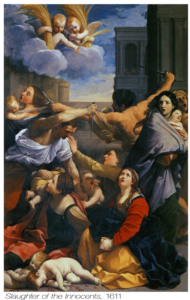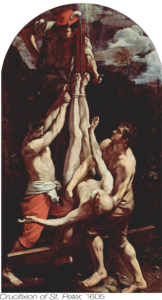Object of the Month: July 2019
The Four Evangelists: Matthew, Mark, Luke, John
Oil on Canvas, 1630s
Guido Reni
Bolognese, 1575-1642
The painter of this elegant series of the Four Evangelists is Guido Reni. Reni is not only one of the most revered 17th-century painters but also one of the Baroque era’s most fascinating personalities. His friend Carlo Cesare Malvasia wrote an illuminating biography acknowledging the painter’s paradoxical character. Although deeply religious, Reni was plagued by an addiction to gambling; although renowned for his generosity, he was notoriously thin-skinned, and although labeled conventionally “prim,” he was one of the few artists of the time willing to mentor female painters (most notably Elisabetta Sirani). Regardless, throughout his life Reni is said to have “cut an impressive aristocratic figure, always fashionably and expensively dressed and usually attended by servants.”
Born in Bologna in 1575, Reni began his training in the studio of Denys Calvaert. In his late teens, he entered the Carracci Academy where he continued studying until 1598 when he embarked on an independent art career. Despite his initial success, he soon realized that to expand (and solidify) his reputation he would have to study in Rome. He left for the “eternal city” in 1601, and for the next thirteen years he immersed himself in Rome’s rich artistic heritage. He returned to Bologna in 1614 and remained there for the rest of his life. His thriving Bolognese studio received commissions from all over Europe, and Ian Chilvers notes, “Rubens was the only contemporary painter who had a more glittering international clientele.”
Reni’s 1611 Slaughter of the Innocents reflects the tight brushwork, pristine finishes, and rich coloration of his early work. While in Rome, he did flirt briefly with the popular Caravaggesque style (as seen in the Crucifixion of St. Peter). However, he soon returned to his classical roots. David Steele observes that as his style continued to mature, “his colors become progressively more silvery and his brushwork more free.”
We see evidence of this tonal shift and looser brushwork in M&G’s gospel writers—particularly in the renderings of Matthew, Mark, and Luke. The more vibrant coloration of the St. John figure relates to his iconography. This “beloved disciple” is often dressed in red and green garments (red symbolizing his love for Christ and green representing his faith in the resurrection.) Also apparent in the upper right of John’s canvas is an eagle; this identifier symbolizes the “soaring inspiration” mirrored in the artful imagery that opens his gospel and illuminates his book of revelation. This attribute is derived from the “four living creatures” surrounding God’s throne (referenced in both Ezekiel and Revelation). Each of the gospel writers has an identifier related to these tetramorphs as they are called: Matthew’s is the angel (clearly visible in his portrait), Mark’s is the lion (in the lower right of his canvas), and Luke’s the ox (faintly visible in the upper right of his portrait). Irenaeus of Lyon was the first to associate these mystical creatures with the four gospel writers, but it was the Church Father Jerome who assigned each their specific identifier.
By the end of his life, Reni had become the most famous Italian painter of his day. His style is still regarded as “perfectly poised between formal precision and expressive density” (Baroque Painting, p. 82) Although he briefly fell out of favor during the 19th century, his reputation as the “divine Guido” remains firmly intact.
Donnalynn Hess, Director of Education
Published in 2019


